Remembering Operation Defensive Shield in Jenin, 20 Years Later
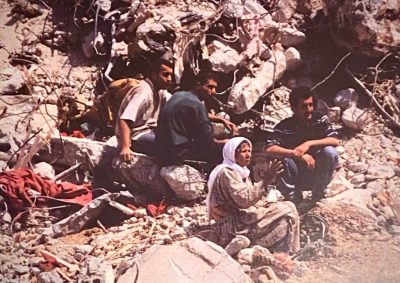
All Global Research articles can be read in 51 languages by activating the “Translate Website” drop down menu on the top banner of our home page (Desktop version).
To receive Global Research’s Daily Newsletter (selected articles), click here.
Visit and follow us on Instagram, Twitter and Facebook. Feel free to repost and share widely Global Research articles.
***
From approximately April 3-17, 2002 Israeli military forces stormed the Jenin refugee camp, killing more than 50 Palestinians and making 13,000 people homeless. Jennifer Loewenstein remembers touring camp in the aftermath, and the media’s indifference to the onslaught.
In late March 2002 as the Second Intifada raged on, the Israeli Defense Forces (IDF) launched Operation Defensive Shield against cities and towns in the occupied West Bank. Defensive Shield was the biggest military operation in the territory since 1967 with Israeli military forces invading Ramallah, Tulkarem, Qalqilya, Nablus, Bethlehem, and Jenin. The operation was said to have been a direct response to the March 27th suicide bombing at the Park Hotel in Netanya that killed 30 vacationers, known also as the “Passover Massacre.”
The purpose of “Defensive Shield” was to reassert Israeli control over the major population centers of the West Bank. [1] The plans for Defensive Shield, however, had been laid out in a 1996 blueprint known as “Operation Field of Thorns” drafted by then Chief of Staff Moshe Ya’alon. It was drawn up in response to three days of violent clashes beginning on 24 September 1996 that followed Israel’s opening of a tourist tunnel that would link the Western Wall, Judaism’s most sacred site, with the Via Dolorosa (where, in Christian tradition, Jesus is said to have walked on his way to the crucifixion) and pass by several Islamic holy sites.[2] In the violence that ensued 25 Israeli soldiers and nearly 100 Palestinians died. Over 1,000 Palestinians were wounded both in East Jerusalem and Gaza where the violence had spread. [3]
The purpose of Operation Field of Thorns was to develop a clear military strategy to retake the West Bank, crush Palestinian resistance, and transfer Palestinians out of the territory, or ‘sensitive areas’. Operation Defensive Shield was less radical than Field of Thorns but shared similar goals and was no less violent in its implementation. [4]
From approximately April 3rd -17th, 2002 Israeli military forces stormed the Jenin refugee camp to pursue ‘terrorists’. (Different sources provide different dates for when the IDF left the camp.) In fact, however, the demolition of the camp was an act of collective punishment that lasted at least two weeks. Jenin was targeted, in this case, ostensibly because it was home to the man responsible for the suicide bombing in Netanya. Jenin was a “hotbed of terrorism,” claimed Israeli Prime Minister, Ariel Sharon. This doesn’t explain why the other Palestinian cities were targeted in the operation or why an entire refugee camp had to pay the price.
IDF forces, including 150 tanks, armored personnel carriers, Apache helicopters, and F-16 fighter jets along with 2 regular infantry battalions, commando teams, and 12 D9 armored bulldozers pummeled the camp in dense, urban warfare in a campaign that would leave at least 52 Palestinians dead and scores wounded (52 is the official figure; many claim the death toll was higher). [5] Twenty-three Israeli soldiers also died. According to Human Rights Watch, 22 of the 52 Palestinian dead were civilians. [6] To this day people are divided over whether or not to call the battle of Jenin a massacre, arguing over whether or not it fits the dictionary definition of an “act or instance of killing a large number of humans indiscriminately and cruelly.” Amnesty International compiled a detailed report on Operation Defensive Shield in which it states:
During the fighting Palestinian residents and Palestinian and foreign journalists and others outside the camp saw hundreds of missiles being fired into the houses of the camp from Apache helicopters flying sortie after sortie. The sight of the firepower being thrown at Jenin refugee camp led those who witnessed the air raids, including military experts and the media, to believe that scores, at least, of Palestinians had been killed. The tight cordon round the refugee camp and the main hospital from 4-17 April meant that the outside world had no means of knowing what was going on inside the camp;… [7]
In its report, Amnesty also documents unlawful killings; the use of Palestinians as human shields; torture and cruel, inhuman or degrading treatment of detainees; a lack of access to food and water; blocked medical and humanitarian assistance; and the widespread destruction of property and civil infrastructure. [8]
In the spring of 2002 I lived and worked in Gaza City, Gaza. Palestinians from the Gaza Strip were not allowed to travel to the West Bank so the Mezan Center for Human Rights (where I worked) sent me to report from the refugee camp in Jenin. I arrived on the 18th of April and the following is an account of what I saw. It is taken from articles I wrote at the time, a diary I kept of the events, what I remember cross-checked with facts, and the countless pictures I took, some of which became part of an exhibit.
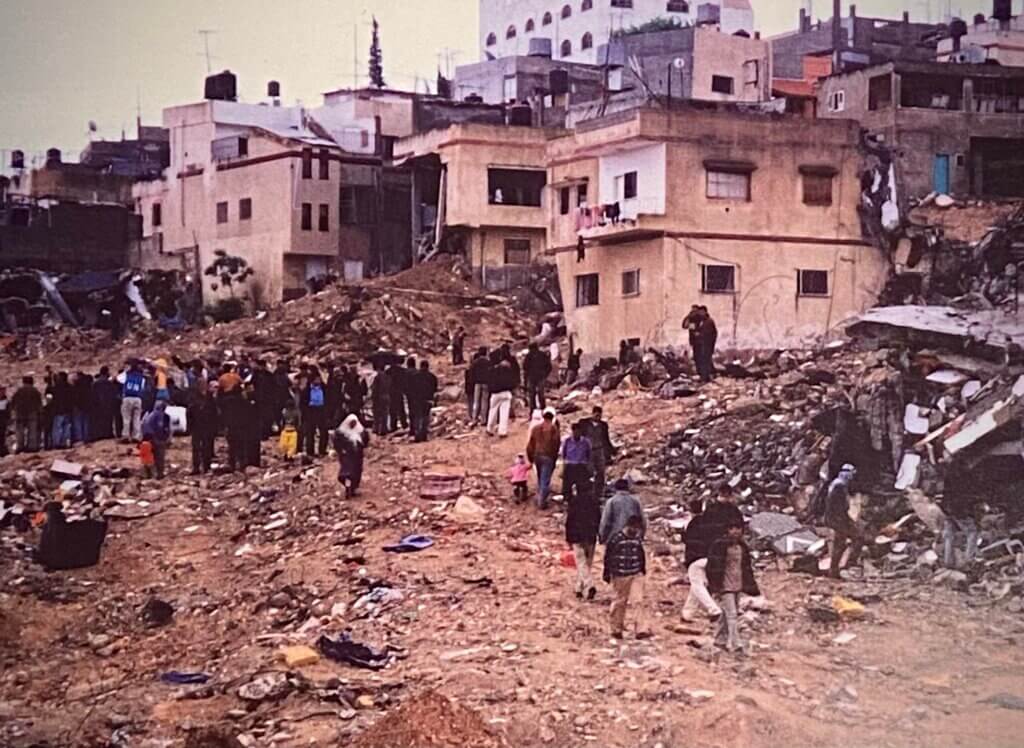
A Group Of Observers Enters Jenin Refugee Camp From The South Side, April 2002. Photo By Jennifer Loewenstein.
At first, I didn’t know if I was in the right place. Before me was a landscape of ruin. I remember asking an old man where the camp was. He gave me a look, gestured toward the wreckage and said, “al-mukhayim!” (“the camp!”) That’s when it hit me just how devastating the destruction had been. I wandered from heap to heap of debris often not even knowing what I was seeing. The ground was muddy and there were people, including women and children, trying to salvage personal property, clear pathways around the fallen buildings for emergency medical teams, and locate the dead.
The smell of death permeated the camp. I’d heard of people talking about ‘the terrible smell of death’ but until then had never experienced it. When I did, I knew what it was almost instinctively. In the ruins of someone’s home, I saw the bottom of a shoe sticking out of a pile of dirt. Around me people held pieces of cloth over their noses and mouths to keep from gagging at the smell. That’s when I realized the shoe was attached to a foot, and the foot to a person. To keep out of the way, I left the area and walked to what I now know was the entrance to the camp – where the hospital was. I walked through its mostly empty hallways until I came to the back entrance. Outside there was a lot of commotion.
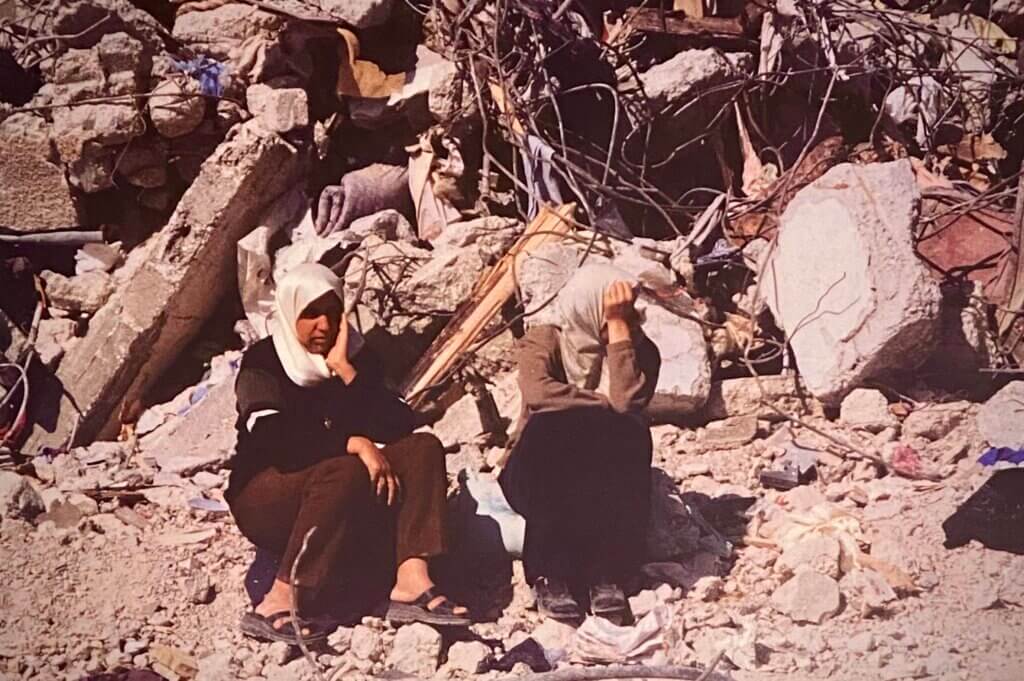
Two Girls Sitting Outside Their Destroyed House. Photo By Jennifer Loewenstein
I moved away from the throng of people and climbed up on a ledge overlooking the area in back of the hospital. There, the dead were wrapped in white sheets and lay on the ground in the sun. Workers piled some of the bodies into the back of a pickup truck, leaving the rest lined up next to each other, their names scribbled in black marker on the sheets, for the living to identify. A young man knelt before one of the bodies, deep in thought or prayer or grief. Behind the rows lying in the sunlight, men dug open a grave where those who had died during the siege had been buried. The grave had been dug hastily so that the bodies of those who had died would not spread disease. Now they were unearthed, brushed free of dirt, and lined up alongside the others. They, too, would be loaded onto the truck and taken away for proper burial.
An old woman stood in the center of this commotion screaming at the journalists to stop taking pictures. The journalists ignored her, snapping photographs anyway: the need for proof of what happened overruled preserving the dignity of the dead. Two men carrying a makeshift stretcher brought another body in from the camp. I didn’t count how many bodies were there. At the time, it didn’t occur to me that so much controversy would surround the number of people killed.
Earlier, on that day after the siege ended, I had stood in a line with foreign reporters waiting for permission from the army to enter the camp and document the aftermath. We filed down a snaking path from a nearby village. I came to understand that we took this path to avoid being fired at by soldiers who’d remained behind, but the soldiers fired anyway –above our heads. Undaunted, this procession of outsiders moved in anyway: Eastern Europeans, a Greek photographer, a couple of Italians, some Lebanese, a Russian, and a collection of others. Only one other American, a student from the Midwest, and a British NGO volunteer entered with us.
This was the first time civilians, journalists and photographers –except for a very few who had risked their lives to get in earlier —had been allowed in. The perpetrators had not wished to be filmed with their bulldozers, guns, and bombs; their helicopter gunships, their missiles, their use of human shields; the explosives they used to blow up buildings and family homes, one with a paralyzed man in a wheelchair still inside. [9] Evidently, they didn’t want outsiders to know that electricity, water, food, and medical supplies had been cut off; that no one was allowed in or out. They didn’t want observers to see how soldiers burned family photographs; how they urinated and defecated in kitchen pots and pans; stuck pins into and ripped up children’s toys; fired missiles into people’s living rooms; slashed women’s clothing, and dumped supplies of food on kitchen floors; how they ruined furniture and smashed cups, plates, bowls, glasses, vases, picture frames, televisions, and radios on the ground. In the hallway of a school at the back of the camp someone had taken great care, with something like an exacto knife, to scratch the eyes out of each of the children painted on a wall mural. When it was all over, some laughed or bragged at the destructiveness in overdrive.[10] In a now infamous interview, a soldier nicknamed Kurdi Bear (Moshe Nissim), recalled his time driving an armored bulldozer around the camp. With a bottle of whiskey stashed up front, Kurdi Bear spent three days straight demolishing what he could of the camp.
For three days I just destroyed and destroyed. The whole area. Any house that they fired from came down. And to knock it down, I tore down some more. They were warned by loudspeaker to get out of the house before I come (sic), but I gave no one a chance. …I would just ram the house with full power, to bring it down as fast as possible. Others may have restrained themselves, or so they say. Who are they kidding? … I didn’t give a damn about the Palestinians, but I didn’t just ruin with no reason. It was all under orders. Many people were inside the houses we sought to demolish. … I didn’t see, with my own eyes, people dying under the blade of the D-9. And I didn’t see house falling down on live people. But if there were any, I wouldn’t care at all. … I really enjoyed it. I remember pulling down a wall of a four-story building. We would go for the sides of the buildings, and then ram then. If the job was too hard, we would ask for a tank shell. … On Sunday… after the fighting was over, we got orders to pull our D-9s out of the area and stop working on our ‘football stadium’, because the army didn’t want the cameras and the press to see us working.
Now the work was done and the same soldiers responsible for this had retreated outside the camp to rest. Some sat on their tanks talking to one another; some walked around, guns slung over their shoulders. Others relaxed on the grass watching the parade of cars and trucks going in and out. A group of soldiers sat on a bench eating ice cream.
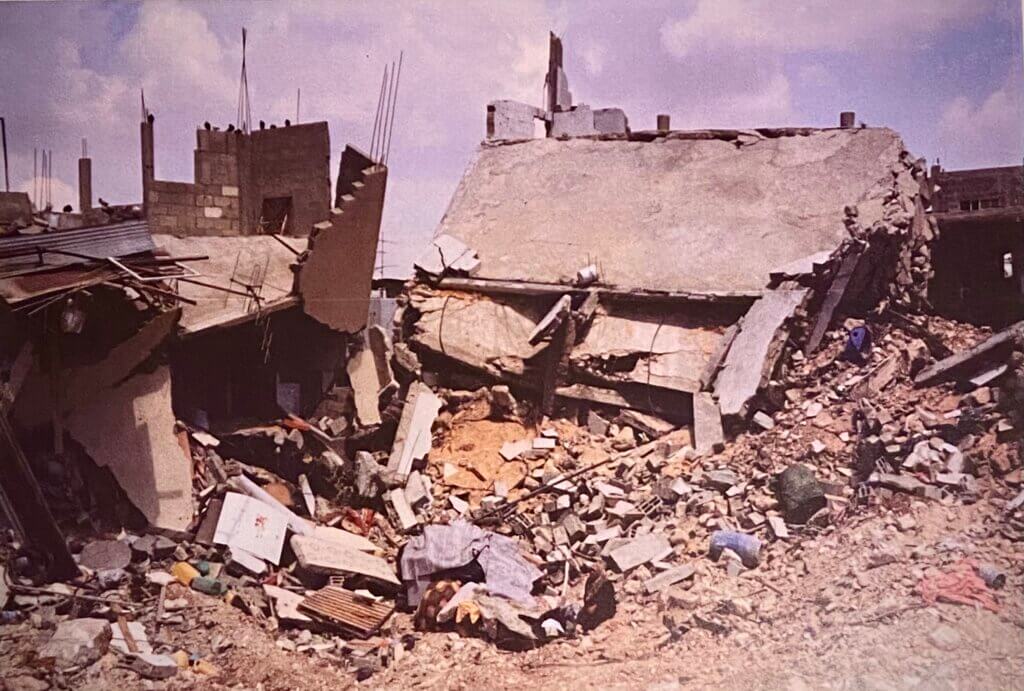
Jenin Refugee Camp After The Onslaught, April 2002. Photo By Jennifer Loewenstein.
In the aftermath, there was still no water or electricity or food available for the inhabitants because there was no camp. It had been flattened; wrecked beyond recognition. A few empty homes, their windows and doors blackened and blown out, stood empty, as if gaping in shock. More than thirteen thousand people fled the camp in terror, became refugees of the refugees. Husbands, fathers, sons, and brothers disappeared, leaving behind family members with no idea how to find them. At the end of that first day, just before twilight, a wooden shack at the edge of the camp exploded and burst into flames.
There had never been a call to ship in equipment and arms to help the resistance, and no recognition that it was resistance. There was no mainstream acknowledgment of the vastly superior attacking forces or their violations of international law. US Secretary of State Colin Powell took nearly a week to arrive in Israel, claiming his mission to broker a ceasefire was “not in the least in jeopardy” as the battle in Jenin continued. In a joint statement by the Mideast “Quartet” (Colin Powell, UN Secretary General Kofi Annan, EU policy chief Javier Solana, and Russian Foreign Minister Igor Ivanov), Israeli Prime Minister Sharon was asked to “withdraw from Palestinian areas” and Palestinian leader, Yasser Arafat, was called on to “rein in terrorism”. “Terrorism, including suicide bombing, is illegal and immoral,” the statement said. and Israel “must fully comply with international humanitarian principles [and] …allow full and unimpeded access to humanitarian organizations and services. [11] The statement was, of course, ignored.
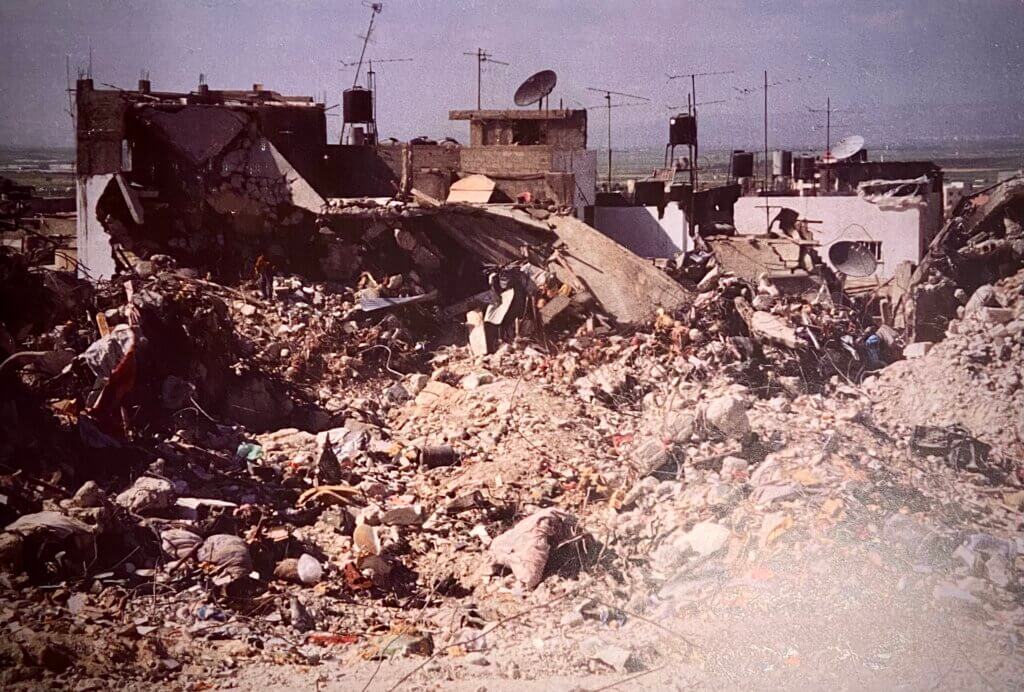
Rubble Of Jenin Refugee Camp, April 2002. Photo By Jennifer Loewenstein.
Ariel Sharon insisted it would be a “tragic mistake” for Powell to meet with Yasser Arafat and claimed the “operation” was in “self-defense” though inside the camp a Palestinian fighter informed a resistance leader by phone that they had run out of ammunition. [12]
“I hope our great friend the United States understands that this is a war of survival for us …it’s our right to defend our citizens and there should be no pressure put on us not to do that,” Mr. Sharon told reporters as he toured an army command post overlooking the Jenin refugee camp where Israeli troops have battled armed Palestinians this week. [13]
The US announced it would veto any Security Council resolution condemning Israel’s actions.
After the siege, there were no Lester Holts or Anderson Coopers in Jenin to tell the world what had happened, interviewing survivors who had lost everything in the fighting, filming their tears, getting their stories firsthand with an accompanying camera crew and translators. There were no images of mothers carrying their babies or old women weeping because they’d lost their sons, their homes, their neighbors; CNN, MSNBC, ABC, and the other US media giants weren’t filming people hunkered down in underground bunkers for safety (though in fact there were no bunkers or shelters of any kind). There were no military analysts asked to speak on TV, or foreign ministers vowing hospitality if the refugees fled to their nations; no promises that they’d be taken in “with open arms–no questions asked”. There were no political pundits to assess the circumstances or guess what would come next.
Western journalists recorded no sound bites of men who had stayed behind to fight because this was their land. Aid organizations could send no humanitarian aid packages into the camp to help the inhabitants survive under siege. There were no walks through the hospital to film people with shrapnel wounds or bandages around their heads and limbs; no footage of bombed and bulldozed buildings and no commentators holding back tears. There were no images of children clinging on to their mothers’ sides or of people carrying away their beloved pets to keep them safe.
On the contrary, there was solidarity with the Israelis. This radical absurdity prevailed as the media conglomerates landed instead in Jerusalem and Tel Aviv to shake hands with the perpetrators, swearing solidarity with the occupiers and guaranteeing more military aid. Imagine these same actors landing in Moscow for a wrap-up of events. The residents of Jenin were ignored. When I finally left on the afternoon of 20 April 2002, I remember glancing back at the piles of rubble. On one jagged heap of broken concrete, someone had planted the black flag of Islamic Jihad.
Jenin has been forgotten. It was 20 years ago after all. Why remember it—when there have been far more horrible operations in Palestine, especially Gaza, since then: Operation Cast Lead, Operation Summer Rains, Operation Autumn Clouds, Operation Hot Winter, Operation Pillar of Defense, Operation Protective Edge, Operation Guardian of the Walls (just a year ago, in May 2021) –to mention but a few. It has become more difficult if not impossible for the media to enter at all and, on 15 May 2021, an Israeli airstrike knocked down the Jala’a Tower, home to a number of foreign media agencies including the Associated Press and Al-Jazeera., claiming without evidence that it hosted a Hamas jamming station. This made it nearly impossible for news media from within the Gaza Strip to reach the outside world. After the strike, Israeli military forces submitted an edited report to US Secretary of State Tony Blinken who reported that the strike had been “necessary”. [14]
As scenes of the war in Ukraine pervade living rooms across the country, and death, destruction, and human suffering are decried from coast to coast, other people’s forgotten wars and battles are demanding acknowledgment for the suffering, death, and displacement they caused. Many such anniversaries pass without notice except by those who lived through them, haunted by images deliberately buried and denied. Outrage at the hypocrisy of Western nations saluting Ukraine, lighting up their cities with the blue and yellow of the Ukrainian flag, and plastering pictures of Ukrainian President Volodymyr Zelensky, among other things, would be mitigated by, especially, a recognition of US and US-backed crimes.
Commemorating such events has therefore become that much more necessary: as in many cases, resistance begins with memory. Remembering often provokes action, and can harness popular discontent. If the news media fails because of its subservience to the state, it becomes the burden of individual citizens to correct the record; to monitor and check the centers of power.
Jenin is just one symbol of forgotten battles. Ukraine has reminded us just how compelling media can be, even when it is used for questionable reasons, and how states and other actors should (or could) respond to human crises. Remembering Jenin, or any forgotten crime, is an act of resistance; a confrontation of our past, and a demand to change the present. It is a first step toward popular action and hope for the future.
*
Note to readers: Please click the share buttons above or below. Follow us on Instagram, Twitter and Facebook. Feel free to repost and share widely Global Research articles.
Jennifer Loewenstein is faculty associate of Middle East Studies at the University of Wisconsin-Madison; LEAP project administrator; and founder of the Carol Chomsky Memorial Fund.
Notes
- https://www.jewishvirtuallibrary.org/operation-defensive-shield
- https://electronicintifada.net/content/they-cant-distinguish-forest-trees/4366 (Field of Thorns) and https://www.csmonitor.com/1996/0930/093096.intl.intl.1.html
- https://www.latimes.com/archives/la-xpm-1996-09-25-mn-47381-story.html
- Between The Lines
- https://reliefweb.int/report/israel/israeli-forces-commit-massacre-jenin-refugee-camp
- https://www.hrw.org/news/2002/05/02/israel/occupied-territories-jenin-war-crimes-investigation-needed# &
https://www.hrw.org/reports/2002/israel3/ - https://www.amnesty.org/en/wp-content/uploads/2021/10/mde151432002en.pdf
- https://www.amnesty.org/en/wp-content/uploads/2021/10/mde151432002en.pdf
- https://www.hrw.org/news/2002/05/02/israel/occupied-territories-jenin-war-crimes-investigation-needed# & https://www.hrw.org/reports/2002/israel3/
- http://www.hartford-hwp.com/archives/51a/041.html
- https://www.wsj.com/articles/SB1018466560712917120
https://www.wsj.com/amp/articles/SB1018466560712917120 - https://www.wsj.com/articles/SB1018466560712917120
https://www.wsj.com/amp/articles/SB1018466560712917120 - https://www.wsj.com/articles/SB1018466560712917120
https://www.wsj.com/amp/articles/SB1018466560712917120 - https://www.middleeasteye.net/news/israel-gaza-media-tower-bombing-edited-intelligence-handed-us-justify
Featured image: A Family On The Rubble Of Their Home In Jenin Refugee Camp, April 2002. Photo By Jennifer Loewenstein.

